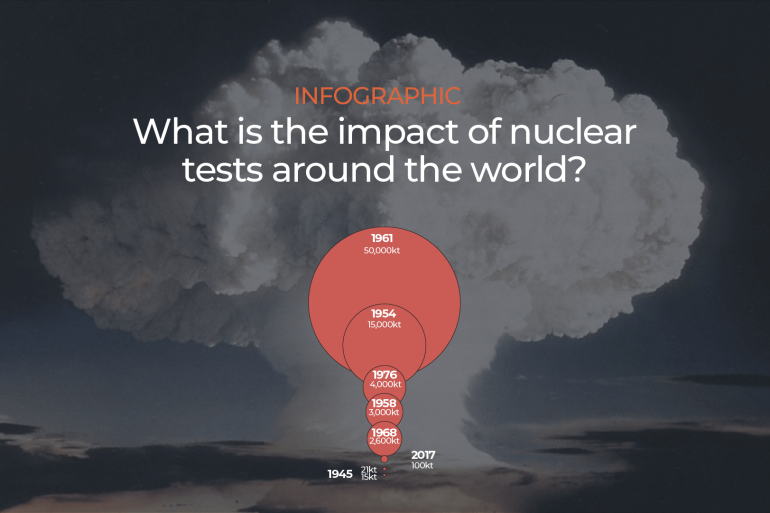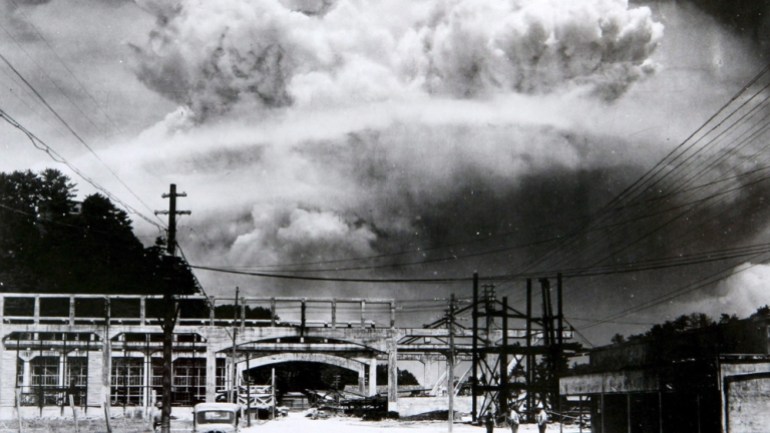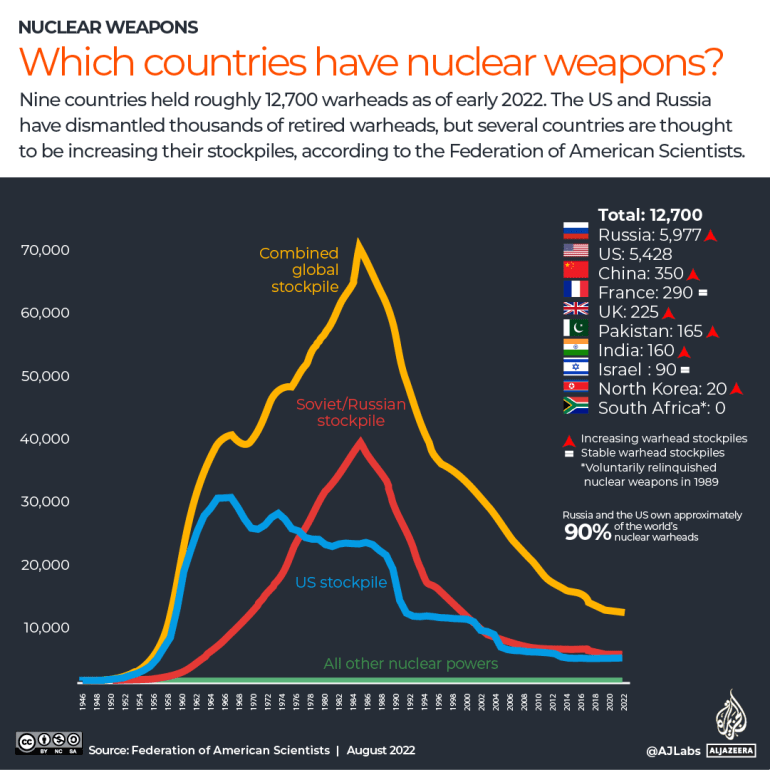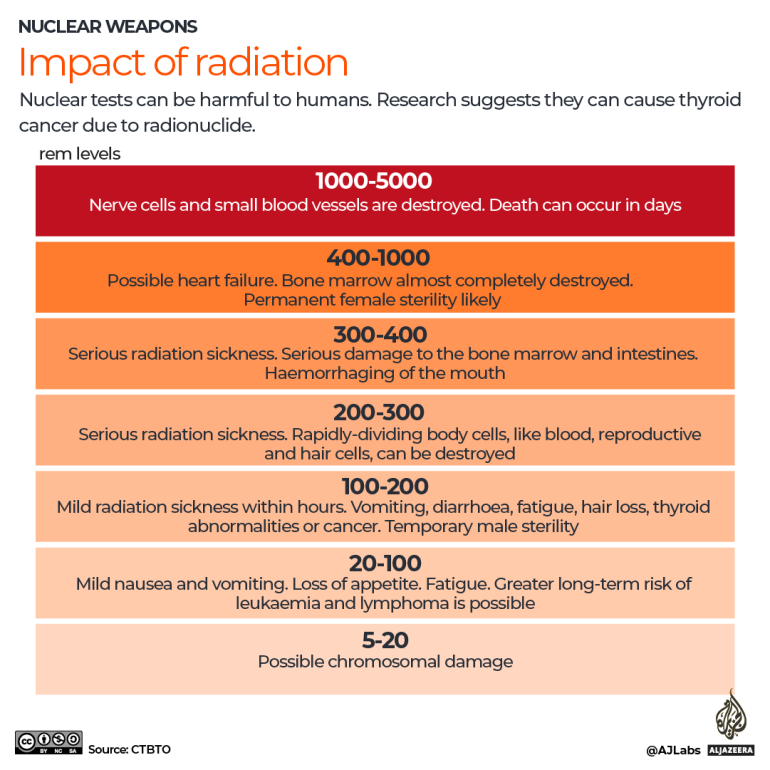Infographic: The impact of nuclear tests around the world
Since 1945, more than 2,000 nuclear test explosions have been conducted by at least eight nations.

August 29 marks the International Day against Nuclear Tests. The day, declared by the United Nations in 2009, aims to raise awareness of the effects of nuclear weapons testing and achieve a nuclear-weapons-free world.
On July 16, 1945, during World War II, the United States detonated the world’s first nuclear weapon, codenamed Trinity, over the New Mexico desert.
Keep reading
list of 4 itemsMapping Israel-Lebanon cross-border attacks
Eid Mubarak: Hear greetings in different languages
When is Eid al-Fitr 2024 and how is it celebrated?
Less than a month later, the US dropped two atomic bombs on the Japanese cities of Hiroshima and Nagasaki, killing more than 100,000 people instantly.
Thousands more died from their injuries, radiation sickness and cancer in the years that followed, bringing the toll closer to 200,000, according to the US Department of Energy’s history of the Manhattan Project.

Nuclear warheads per country
Nine countries possessed roughly 12,700 warheads as of early 2022, according to the Federation of American Scientists. Approximately 90 percent are owned by Russia (5,977 warheads) and the US (5,428 warheads).
At its peak in 1986, the two rivals had nearly 65,000 nuclear warheads between them, making the nuclear arms race one of the most threatening events of the Cold War.
While Russia and the US have dismantled thousands of warheads, several countries are thought to be increasing their stockpiles, notably China.
The only country to voluntarily relinquish nuclear weapons is South Africa. In 1989, the government halted its nuclear weapons programme and in 1990 began dismantling its six nuclear weapons. In 1991, South Africa joined the Treaty on the Non-Proliferation of Nuclear Weapons (NPT) as a non-nuclear country.

Which countries have carried out nuclear tests?
According to the Arms Control Association, at least eight countries have carried out a total of 2,056 nuclear tests since 1945.
The US has conducted half of all nuclear tests, with 1,030 tests between 1945 and 1992. In 1954, the US exploded its largest nuclear weapon, a 15 megatonne bomb, on the surface of the Bikini Atoll in the Marshall Islands, the test was codenamed Castle Bravo. The power of the nuclear test was miscalculated by scientists, and it resulted in radiation contamination that impacted inhabitants of the atolls. The nuclear fallout of the explosion is said to have spread over 18,130 square kilometres (7,000 square miles).
The Soviet Union carried out the second highest number of nuclear tests at 715 tests between 1949 and 1990. The USSR’s first nuclear test was on August 29, 1949. The test, codenamed RDS-1, was conducted at the Semipalatinsk test site in Kazakhstan. According to the CTBTO, the Soviet Union conducted 456 tests at the Semipalatinsk test site, with devastating consequences for the local population such as genetic defects and high cancer rates.
Kazakhstan closed the Semipalatinsk test site on August 29, 1991. Following this move, the UN established August 29 as the International Day against Nuclear Tests in 2009.
France has carried out 210 nuclear tests, while the United Kingdom and China have each carried out 45 tests.
India has carried out three nuclear tests, while Pakistan has carried out two.
North Korea is the most recent nation to carry out a nuclear test. In 2017, its sixth and most powerful bomb was detonated at the Punggye-ri nuclear test site. The underground explosion created a magnitude-6.3 tremor.

The largest nuclear detonations
The largest nuclear explosion occurred in 1961, when the Soviet Union exploded the Tsar Bomba on Novaya Zemlya north of the Arctic Circle. The explosion’s yield was 50 megatonnes, 3,300 times more powerful than the nuclear bomb dropped on Hiroshima.
Other major nuclear explosions by different nations include China’s largest detonation in Lop Nur in 1976, the test had a yield of four megatonnes.
The UK conducted a series of nuclear tests in the South Pacific Ocean between November 1957 and September 1958 as part of Operation Grapple. Grapple Y was the largest of the operation’s nuclear tests, with a yield of three megatonnes.
A survey conducted in 1999 by the British Nuclear Veterans Association found that the impact of the tests on 2,500 veterans who had been present showed skeletal abnormalities and 30 percent of the men had died, mostly in their fifties.
In 1968, France conducted a series of nuclear tests codenamed Canopus at Fangataufa Atoll in the South Pacific Ocean. The test had a yield of 2.6 megatonnes and was 200 times more powerful than the Hiroshima bomb.

Nuclear test sites
Nuclear weapons have been tested all around the world.
On February 13, 1960, France carried out its first nuclear test, codenamed Gerboise Bleue, over the Sahara desert in Algeria – which it was occupying at the time.
Other nuclear test sites include a number in the United States in the states of Nevada, New Mexico, Colorado and Mississippi.
Tests have been carried out in Australia, China, India, Kazakhstan, North Korea, Russia, and Pakistan as well as on French Polynesia, Kiritimati, the Marshall Islands, Prince Edward Island in the Indian Ocean and in the open sea in the eastern Pacific and south Atlantic Ocean.
In 1979, a US Vela satellite detected an atmospheric nuclear explosion over Prince Edward Island in the Indian Ocean. Many believe this was an undeclared joint nuclear test carried out by South Africa and Israel.

What does a nuclear test involve?
Nuclear explosions are either detonated in the atmosphere or underground.
About a quarter of all nuclear tests were detonated in the atmosphere, which spread radioactive materials through the air. To minimise the release of radioactive material, most nuclear tests are underground.
Before a nuclear test is conducted, a suitable test site must be located and prepped. A hole is drilled into the ground in which the nuclear device is placed.
The hole is stemmed with gravel, sand and other materials to prevent radioactive material from escaping. Radiation monitors are activated and aircraft circle the test site to track the capabilities of the device, with weather and fallout patterns being reviewed.
When the device is detonated, energy is released almost instantaneously, producing high temperatures and pressure, which vaporise the nuclear device and the surrounding subterranean rock area.
A cavity forms where the detonation happened and, as the hot gases cool, molten rock puddles at the bottom of the cavity. After a while, the weight of the overburden causes the cavity roof to collapse and a rubble chimney extends to the surface, forming a subsidence crater – a bowl-shaped depression with a diameter of up to 600m (1969 feet) and a depth of up to 60m (197 feet).
After the test is conducted, the site remains guarded – samples and data are retrieved later.

Impact of different levels of radiation
Nuclear testing has immediate and long-term effects caused by radiation and radioactive fallout. Increased rates of cancer have been associated with nuclear testing, with studies showing that thyroid cancer is linked to radionuclides.
After a nuclear test, large areas of land remain radioactive for decades after the test.
The health impact of different levels of radiation varies from nausea and vomiting to death within days.
Radiation exposure is measured in roentgen equivalent man (rem) – a unit of radiation measurement applied to humans resulting from exposure to one or many types of ionising radiation.
The infographic below shows the impact of radiation on the human body.
